
Baddesley Clinton is a moated manor house, about 8 miles (13 km) north-west of the town of Warwick, in the village of Baddesley Clinton, Warwickshire, England. The house probably originated in the 13th century, when large areas of the Forest of Arden were cleared for farmland. The site is a Scheduled Ancient Monument and the house is a Grade I listed building. The house, park and gardens are owned by the National Trust and open to the public; they lie in a civil parish of the same name.

Montacute House is a late Elizabethan mansion with a garden in Montacute, South Somerset, England.

Petworth House in the parish of Petworth, West Sussex, England, is a late 17th-century Grade I listed country house, rebuilt in 1688 by Charles Seymour, 6th Duke of Somerset, and altered in the 1870s to the design of the architect Anthony Salvin. It contains intricate wood-carvings by Grinling Gibbons. It is the manor house of the manor of Petworth. For centuries it was the southern home for the Percy family, earls of Northumberland.

Great Chalfield Manor is an English country house at Great Chalfield, about 2.5 miles (4 km) northeast of the town of Bradford on Avon in the west of the county of Wiltshire.

Clevedon Court is a manor house on Court Hill in Clevedon, North Somerset, England, dating from the early 14th century. It is owned by the National Trust and is designated as a Grade I listed building.
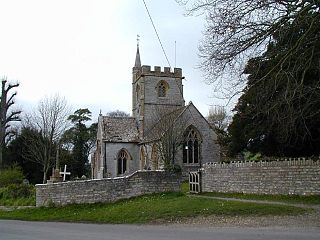
Charlton Mackrell is a village and former civil parish, now in the parish of The Charltons, in the Somerset district, in the ceremonial county of Somerset, England, situated 3 miles (5 km) east of Somerton. The village has a population of 1,020.
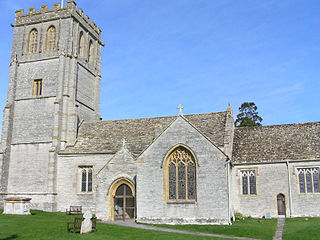
Kingsdon is a village and parish in the South Somerset district of Somerset, England, situated 3 miles (4.8 km) south east of Somerton. The village has a population of 303 but this is set to rise to around 350 once the Kingsdon Manor development is complete. The majority of the houses in the village are clustered on the side of the hill from which there are scenic views across the Somerset countryside.

Oxburgh Hall is a moated country house in Oxborough, Norfolk, England. The hall was built for Sir Edmund Bedingfeld who obtained a licence to crenellate in 1482. The Bedingfelds gained the manor of Oxborough through marriage in the early 15th century, and the family has lived at the hall since its construction, although ownership passed to the National Trust in 1952. The house underwent extensive refurbishment in the mid 19th century under John Chessell Buckler and Augustus Pugin.

Little Moreton Hall, also known as Old Moreton Hall, is a moated half-timbered manor house 4.5 miles (7.2 km) south-west of Congleton in Cheshire, England. The earliest parts of the house were built for the prosperous Cheshire landowner William Moreton in about 1504–08 and the remainder was constructed in stages by successive generations of the family until about 1610. The building is highly irregular, with three asymmetrical ranges forming a small, rectangular cobbled courtyard. A National Trust guidebook describes Little Moreton Hall as being "lifted straight from a fairy story, a gingerbread house." The house's top-heavy appearance, "like a stranded Noah's Ark", is due to the Long Gallery that runs the length of the south range's upper floor.

Dunster Castle is a former motte and bailey castle, now a country house, in the village of Dunster, Somerset, England. The castle lies on the top of a steep hill called the Tor, and has been fortified since the late Anglo-Saxon period. After the Norman conquest of England in the 11th century, William de Mohun constructed a timber castle on the site as part of the pacification of Somerset. A stone shell keep was built on the motte by the start of the 12th century, and the castle survived a siege during the early years of the Anarchy. At the end of the 14th century the de Mohuns sold the castle to the Luttrell family, who continued to occupy the property until the late 20th century.

Burlescombe is a village and civil parish in the Mid Devon district of Devon, England. The parish is surrounded, clockwise from the north, by the parishes of Holcombe Rogus, Culmstock, Uffculme, Halberton and Sampford Peverell. According to the 2001 census it had a population of 911. The village is about 5 miles (8.0 km) south west of Wellington in Somerset. The ruins of the 12th century Canonsleigh Abbey are nearby. Burlescombe is part of the electoral ward of Canonsleigh. The population of this ward was 3,218 at the 2011 Census.
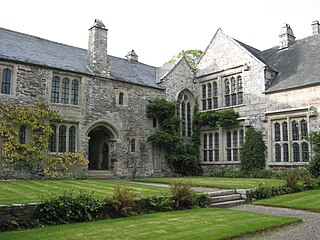
Cotehele is a medieval house with Tudor additions, situated in the parish of Calstock in the east of Cornwall, England, and now belonging to the National Trust. It is a rambling granite and slate-stone manor house on the banks of the River Tamar that has been little changed over five centuries. It was built by the Edgecumbe family in 1458 after the original Manor House was pulled down. Sir Richard Edgecumbe came into the property after fighting for Henry Tudor in the Battle of Bosworth. He was gifted with money and the original Manor House and estate and then proceeded to build Cotehele.

Nettlecombe Court and park is an old estate on the northern fringes of the Brendon Hills, within the Exmoor National Park. They are within the civil parish of Nettlecombe, named after the house, and are approximately 3.6 miles (5.8 km) from the village of Williton, in the English county of Somerset. It has been designated by English Heritage as a Grade I listed building.

Henry Lyte was an English botanist and antiquary. He is best known for two works, A niewe Herball (1578), which was a translation of the Cruydeboeck of Rembert Dodoens, and an antiquarian volume, The Light of Britayne (1588), both of which are dedicated to Queen Elizabeth I.

The Grade I listed buildings in Somerset, England, demonstrate the history and diversity of its architecture. The ceremonial county of Somerset consists of a non-metropolitan county, administered by Somerset County Council, which is divided into five districts, and two unitary authorities. The districts of Somerset are West Somerset, South Somerset, Taunton Deane, Mendip and Sedgemoor. The two administratively independent unitary authorities, which were established on 1 April 1996 following the breakup of the county of Avon, are North Somerset and Bath and North East Somerset. These unitary authorities include areas that were once part of Somerset before the creation of Avon in 1974.
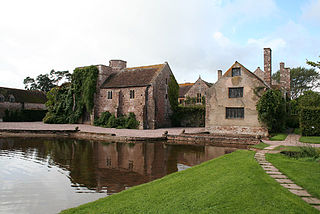
Cothay Manor is a grade one listed medieval house and gardens, in Stawley, near Wellington, Somerset. The manor grounds consist of almost 40 acres and include cottages, outbuildings, stables, and 12 acres of gardens.
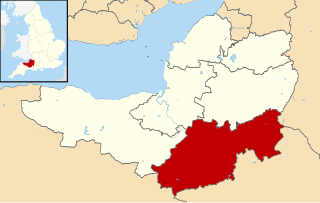
South Somerset is a local government district in the English county of Somerset. The South Somerset district occupies an area of 370 square miles (958 km2), stretching from its borders with Devon and Dorset to the edge of the Somerset Levels. The district has a population of about 158,000, and has Yeovil as its administrative centre.

Nailsea Court in Nailsea, Somerset, England, is an English manor house dating from the 15th century. Pevsner describes the house as "historically highly instructive and interesting" and it is a Grade I listed building.
Gaulden Manor is a Grade II* listed country house to the southeast of Tolland, Somerset, England. It is a double storied building with interior plasterwork, as well as a garden consisting of herbs, old roses and a pond. A room referred to as a chapel has a c.1640 ceiling featuring an angel with trumpet on Judgment Day.
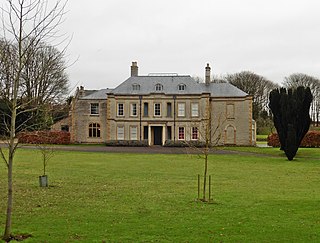
Charlton House is a Grade II* listed house in Charlton Mackrell, Somerset.




























